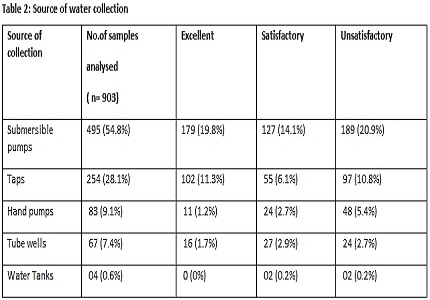Bacteriological analysis of the drinking water from different schools in Northern India: A concern in developing countries
Abstract
Introduction: Potable water is an essential ingredient for good health and the socio-economic development of man. In developing countries, biological contamination of drinking water is a major concern for public health authorities. According to the World Health Organization, approximately 5% of all deaths in these countries are directly related to water diseases resulting from poor quality of drinking water and lack of hygiene and sanitation.
Material and methods: The aim of this study was to determine the water quality of reservoirs at schools in district Amritsar. A total of 903 drinking water samples were collected from various water sources in different schools and the samples were analyzed to assess bacteriological quality of water for presumptive coliform count by multiple tube test.
Results: A total of 39.8% (360/903) samples from various sources were found to be unfit for human consumption. Of the total 360 unsatisfactory samples, 189 were from submersible pumps, 97 were from taps of piped supply (domestic / public), 48 from hand pumps and 26 were from various other sources.
Conclusion: It is therefore important to determine the quality, microbial diversity from water sources consumed by the people, especially used by children, because they are vulnerable to different kinds of diseases since their immune systems are still developing. Bacteriological assessment of all water sources for drinking should be planned and conducted on regular basis to prevent water borne dissemination of diseases.
Downloads
References
2. World Health Organization (WHO).International Standards for Drinking Water. 1985, pp 10-15.
3. Steiner TS, Samie A, Guerrant RL. Infectious diarrhea: new pathogens and new challenges in developed and developing areas. Clin Infect Dis. 2006 Aug 15;43(4):408-10. Epub 2006 Jul 11. [PubMed]
4. Adetunde L, Glover RL. Bacteriological Quality of Borehole Water Used by Students’ of University for Development Studies, Navrongo Campus in Upper-East Region of Ghana. Current Research Journal of Biological Sciences. 2010; 2(6): 361-364.
5. Stephen TO, Joseph KA. Escherichia coli as an indicator of bacteriological quality of water: an overview. Microbiol Res. 2013; 4 (2): 5-11.
6. World Health Organization. 2010. Guidelines for drinking water quality. http://www.who.int/water_sanitation_health/WHS_WWD2010_guidelines_2010.pdf accessed 8.11.2015.
7. Tillett HE. Most probable numbers of organisms: revised tables for the multiple tube method. Epidemiol Infect. 1987 Oct;99(2):471-6. [PubMed]
8. Senior BW. Examination of water, milk, food and air. pp. 883-921. In: Collee J.G., Fraser A.G., Marmion B.P., Simmons A. eds: Mackie and McCartney Practical Medical Microbiology, 1996, 14th edition. Churchill Livingstone, New York. [PubMed]
9. Deepesh K, Shurutikirti M, Molly M, Anita P. Bacteriological analysis of drinking water by MPN method in a tertiary care hospital and adjoining area Western UP, India. Journal of Environmental sciences. 2013; 4(3):17-22. [PubMed]
10. Pritchard M, Mkandawire T, O’Neil JG. Biological, chemical and physical drinking water quality from shallow wells in Malawi: case study of Blantyre, Chiradzulu and Mulanje. Phys. Chem. Earth Parts. 2007; 32: 1167-1175.
11. Heller L, Colosimo EA, Antunes CM. Setting priorities for environmental sanitation interventions based on epidemiological criteria: A Brazilian study. J. Water Health. 2005; 3(3): 271-281.
12. Cairncross S, Blumenthal U, Kolsky P, Moraes L, Tayeh A. The public and domestic domains in the transmission of disease. Trop Med Int Health. 1996 Feb;1(1):27-34. [PubMed]
13. Javed A, Arshad H, Hamida A. The occurrence of coliforms bacteria in water reservoir at different schools of district Peshawar. J. Biochem. Mol. Biol. 2011;44: 64-67. [PubMed]
14. Malhotra S, Arora U, Devi P . How safe is the safe water supply? The internet journal of Microbiology. 2009;7 (1): 27-31.
15. Goel S, Sood R, Mazta S, Bansal P, Gupta A. Bacteriological quality of water samples of a tertiary care medical centre campus in North West Himalayan region of India. Internet journal of Third world Medicine. 2007; 5(1): 5.
16. Kravitz JD, Nyaphishi M, Mandel R, Petersen E. Quantitative bacterial examination of domestic water supplies in the Lesotho Islands: water quality, sanitation and village health. Bulletin of world health organization. 1999; 77 (10): 829-836.
17. Sinha SK. Contamination in some rural ponds water of Muzzarpur (Bihar). Pollution Research. 1991; 10 (3): 179-182.
18. Ramteke PW, Gaur A, Pathak SP, Bhattacharjee JW. Antibiotic resistance of coliforms in drinking water in rural areas. Indian J Med Res. 1990 May;91:185-8. [PubMed]
19. Hunter PR, Fewtrell L. 2001. In: Water quality: Guidelines, Standards and Health. Assessment of risk and risk management of water related infectious diseases. pp 207-227. Fewtrell L, Bardman J eds. IWA, Publishing, London. [PubMed]
20. Prüss A, Kay D, Fewtrell L, Bartram J. Estimating the burden of disease from water, sanitation, and hygiene at a global level. Environ Health Perspect. 2002 May;110(5):537-42. [PubMed]
21. Faria M, Javeria S, Muhammad SA. Bacteriological analysis of drinking water from services hospital Lahore and Services institute of Medical Sciences Lahore. Biomedica. 2010; 26: 66-69. [PubMed]
22. United States Environmental Protection Agency (USEPA). 1976. National Interim Primary Drinking Water Regulations Government Printing Office,Washington, DC.



 OAI - Open Archives Initiative
OAI - Open Archives Initiative


